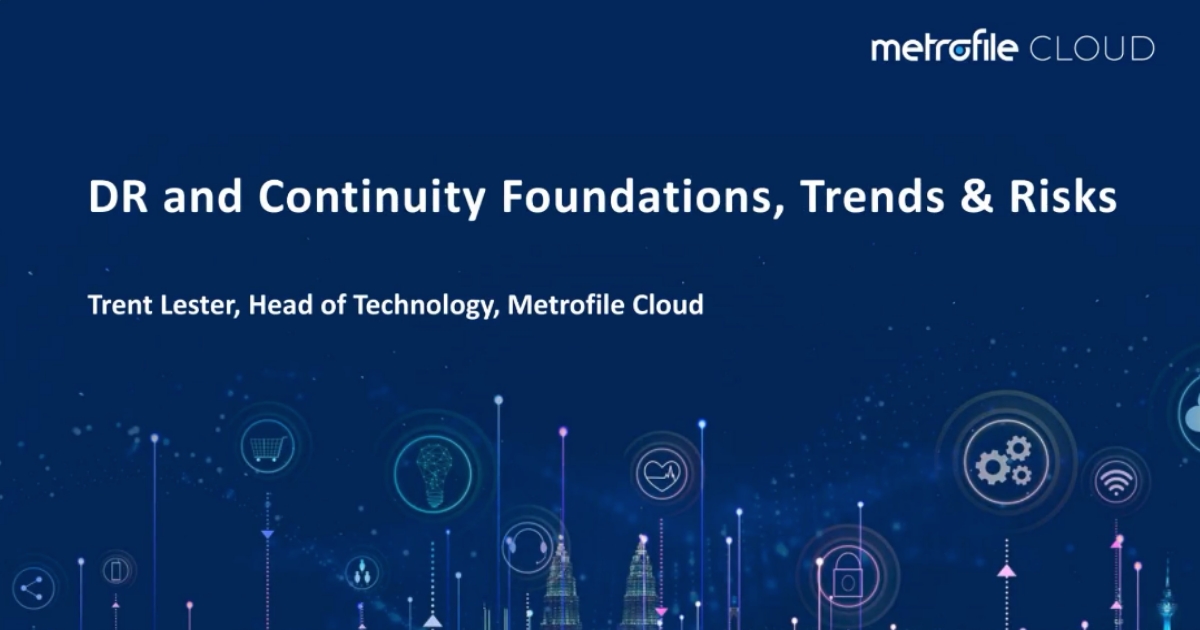South African businesses are facing a rising tide of cyberattacks and system outages. Many believe that having backups means they are fully protected – but when critical systems go down, a backup won’t keep the business running.
A backup is essential, but it only solves one piece of the puzzle. To keep your business running when cyberattacks, outages, or even natural disasters strike, you need something more: Disaster Recovery (DR).
Backup vs. Disaster Recovery: What’s the Difference?
- Backup: Protects files and data
- Disaster Recovery (DR): Protects entire systems, apps, and operations.
Think of backup as saving copies of your files. If you delete a document by mistake or suffer data corruption, you can restore the lost file. That’s helpful – but it won’t get your systems back online if an entire server crashes, ransomware locks your environment, or your office is hit by a flood.
That’s where Disaster Recovery comes in. DR not only protects your data, but also the systems and applications you need to run your business. It allows you to spin up your full environment in the cloud, so your team can keep working while your primary systems are restored.

Or put another way: Backup saves your data. Disaster Recovery saves your business.
Why Disaster Recovery Can’t Wait
- Rising cyberattacks in South Africa.
- Growing compliance demands (finance, healthcare, etc.).
- DR protects not just data, but operations, staff, and customers.
- DR acts as business insurance – not just IT support.
The South African market is still maturing when it comes to DR. Many businesses believe backups are enough, but as threats rise – from ransomware to compliance pressure – the gap between having data copies and maintaining true continuity is widening.
Disaster Recovery is not an IT luxury. It’s business insurance – the safety net that ensures you can serve customers, meet compliance requirements, and protect your reputation even when the unexpected happens.Let’s hear what Steve Porter, MD at Metrofile Cloud has to say in his interview with Ronan McCurtin, RVP for Europe, Israel & Africa at Acronis during their interview post announcement on 22 July, 2025 that Metrofile Cloud is Acronis’ Premier DR Partner in South Africa.
Real-World Proof: When Disaster Recovery Saved SAA
It’s not only mid-tier organisations that are vulnerable. Even South Africa’s largest brands face these challenges.
In May 2025, South African Airways (SAA) suffered a significant cyberattack that disrupted its website, mobile app, and key operational systems. For most businesses, such an incident could have meant many weeks of chaos, grounded operations, and furious customers.
But SAA had prepared. They immediately activated their disaster recovery and business continuity protocols. Normal system functionality was restored the same day – minimising disruption to passengers and safeguarding flight operations.
As reported at the time:
“SAA noted that it had immediately activated its disaster management and business continuity protocols upon discovering the incident. These proactive measures ensured that the airline’s core flight operations remained stable and that essential customer service platforms such as contact centers and sales offices continued functioning without interruption.” – The Cyber Express
How DR saved SAA:
- Cyberattack hit SAA’s website, app, and operations.
- Their DR and business continuity plan was activated immediately.
- Systems were restored within hours, not weeks.
- Flights continued, customers were unaffected.
This is exactly what Disaster Recovery is designed to do: keep the business running even in the middle of a crisis.
The Real Cost of Downtime in South Africa
Downtime isn’t just an IT headache – it’s a business problem. Every hour offline means lost revenue, lost productivity, and potentially lost customers. In highly regulated industries like finance and healthcare, it can also mean compliance fines and reputational damage.
Research shows that downtime costs can run into hundreds of thousands of rand per hour depending on the sector. A financial services company may face costs as high as R1 million per hour, while healthcare downtime can have far-reaching consequences that extend beyond money to patient safety.
👉 Want to know what downtime could cost your business? Download Metrofile Cloud’s Free Downtime Cost Estimator to see the potential impact in your industry. Access it here.
Protect More Than Just Your Data
Backup will always be a vital part of your IT strategy. But as the SAA incident shows, only Disaster Recovery ensures that your business keeps running when disaster strikes.
Don’t wait for downtime to show you the difference. Visit https://metrofile.com/cloud/disaster-recovery-as-a-service/ to learn more about Metrofile Cloud’s Disaster Recovery as a Service (DRaaS) solution.
FAQ
Is backup enough to protect my business?
No. Backup only stores copies of files. DR restores your entire IT environment.
How fast can Disaster Recovery restore operations?
In hours or even minutes, depending on the setup. Backups alone could take days or weeks.
Which industries need Disaster Recovery most?
Finance, healthcare, manufacturing, logistics, retail – any with high downtime costs.
Why is Disaster Recovery especially important in South Africa?
Because cyberattacks are increasing, and downtime costs in regulated industries can run into hundreds of thousands of rand per hour.
Why is Metrofile Cloud the right Disaster Recovery provider for SA businesses?
Metrofile Cloud is Acronis’ Premier DR Partner in South Africa, combining global technology with local expertise.








